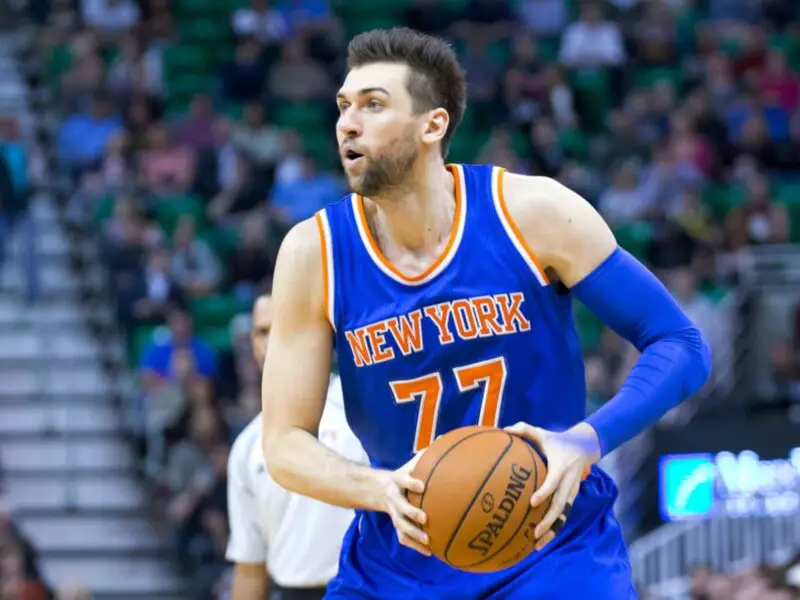Knicks History
The Trade That Haunts Knicks Nation: Revisiting the Andrea Bargnani Disaster of 2013

Reflecting on the past is crucial for the New York Knicks as they look towards the future. One trade stands out as a low point in the team’s history, haunting Knicks fans to this day: the 2013 acquisition of Andrea Bargnani. Many regard it as the worst trade in Knicks history.
At the time, the Knicks had high hopes for the trade. They had just finished a 54-win season and aimed to strengthen their roster for the playoffs. However, the trade proved to be a disaster for the franchise. Bargnani, who was known for his scoring and three-point shooting, did not fit the team’s style of play and struggled to adapt to the physicality of the NBA. Injuries and inconsistency plagued him, ultimately failing to meet the expectations of the organization and fans.
Who did the Knicks trade for Andrea Bargnani?
On July 10, 2013, Andrea Bargnani officially became a Knick. Then GM Glen Grunwald announced they had acquired Bargnani in a trade for Marcus Camby, Steve Novak, Quentin Richardson (via sign and trade), a first round pick in 2016, and two second round picks.
When assessing the deal, the players included were not what made this deal the Knicks worst trade in history. In fact, including these players made a lot of sense. Camby was 40, Novak was given a bigger deal that forced the Knicks hand and Richardson had only appeared in one game the season prior.
The damage in this deal came when they included a first round pick and took on roughly $25million in salary owed to Bargnani.
Related: Reliving the 2009 NBA Draft when Knicks missed Steph Curry
Why did the Knicks make the trade for Bargnani?
Bargnani was described as a “Seven-foot versatile players with a good midrange offensive game and an ability to stretch the other team’s defense are hard to come by in this league,” by GM Grunwald.
He was expected to compliment Carmelo Anthony, Tyson Chandler and Amare Stoudemire. This followed a season where he averaged 12.7 points and 3.7 rebounds per game. This level of productivity was apparently worth risking it all.
The season that followed
After the trade that brought Andrea Bargnani to the Knicks, the team managed to put together a decent season, finishing with a record of 37-45. However, this season marked the beginning of a difficult period for the Knicks.
In the 2013-14 season, Bargnani’s statistics were underwhelming. He averaged 13.3 points and 5.3 rebounds per game, shooting 44.2% from the field and only 27.6% from beyond the arc. However, his biggest problem was his inability to stay on the floor. This issue continued into the 2014-15 season, where he improved his three-point shooting to 36.6% but was again limited by injuries.
The Knicks were never able to gain any traction during this period. They would have short four-game winning streaks followed by five-game losing streaks. This inconsistency made it difficult for the team to build momentum and ultimately led to a lack of success on the court. The Knicks were lacking the stability and consistency that the team needed to win and make the playoffs. The trade for Andrea Bargnani was a turning point for the Knicks in a negative way. It set the team on a path of poor performance, disappointment, and frustration for the fans.
Related: Discover the Potential of Knicks Guard Miles McBride

Carmelo Anthony still performed and put together an All-star year. A year in which he averaged, 27 points, 8 rebounds and 3 assists. The lack of wins was certainly not on his shoulders, but he wasn’t able to take the Knicks to playoffs on his own. The lack of depth as a result of the trade, with the lack of production from Bargnani certainly had its impact.
Who did the Knicks give up for Bargnani?
The New York Knicks’ 2013 trade for Andrea Bargnani is widely considered one of the worst in team history. Along with players, the Knicks also gave up their 2016 first-round pick, which the Toronto Raptors used to select Jakob Poetl. This was a significant loss for the Knicks. The trade also resulted in the loss of draft capital and the financial burden of exorbitant contracts the Knicks had taken on before the trade.
The Knicks believed that Bargnani was the missing piece that would bring them a championship. However, he could not live up to these expectations. In the 2013-14 season, he averaged 13.3 points and 5.3 rebounds per game. He also had a problem staying on the court. This problem persisted into the 2014-15 season.
The Knicks were unable to gain momentum during this period. They had short winning streaks followed by losing streaks. This inconsistency made it difficult for the team to build momentum and ultimately led to a lack of success on the court. The trade for Andrea Bargnani was a turning point for the Knicks, but not in a positive way. It led to a 7-year playoff drought.
The hope for the future of the Knicks organization
Knicks fans can only hope that the current front office will learn from past mistakes and avoid making a similar trade in the future. Building a team through a long-term vision and careful player evaluation is crucial for the success of the franchise. The Knicks need to focus on acquiring players who fit their style of play and can contribute to the team’s success. Additionally, they need to be mindful of overpaying for players and trading away valuable assets.
Related: Knicks Legends: A Stroll Through the Decades of Iconic Players











